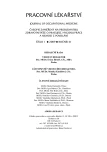Position of nasal exposure tests in diagnostics of occupational rhinitis
Authors:
S. Perečinský; Ľ. Legáth
Authors‘ workplace:
Klinika pracovného lekárstva a klinickej toxikológie LF UPJŠ a FN LP, Košice, Slovensko
prednosta doc. MUDr. Ľubomír Legáth, PhD.
Published in:
Pracov. Lék., 61, 2009, No. 1, s. 21-26.
Category:
Original Papers
Overview
Rhinitis of either occupational or nonoccupational etiology is included among civilization diseases. In some fields, 15% of workers suffer from professional rhinitis. Bakery workers are especially endangered by the development of occupational rhinitis. The aim of the methodology of nasal exposure tests is to verify direct relationship between the occurrence of symptoms of rhinitis and functional signs of nasal obturation in relation to working process. Authors measured the frequency of nasal symptoms using exposure tests in the working environment completed with rhinomanometric examination in bakers and compared the occurrence of symptoms of rhinitis to the occurrence of symptoms of asthma bronchiale. The study includes 41 exposure tests in bakery workers in which the rhinomanometric and spirometric examination before and after the working shift have been undertaken in the bakery. Besides objective examinations, the patient filled in the questionnaire on the occurrence of sneezing, rhinorrhea and nasal obtura- tion during the working process. Nasal obturation was found during the examination of ventral active rhinomanometry after exposure in five workers, whereas obstructive ventilation disorder in relation to working exposure was found only in one worker. The questionnaire results did not correlate with findings of objective examinations of ventral active rhinomanometry. Taking into account the low sensitivity and minimal correlation of questionnaires, nasal provoking tests using functional examination methods have a primary role in diagnostics of occupational rhinitis. It is necessary to continue dealing with the issue of occupational rhinitis since it might present a more significant health and socioeconomic problem than occupational asthma due to the higher occrurrence of symptoms.
Key words:
occupational rhinitis, nasal exposure test, rhinomanometry, bakery workers
Sources
1. AIRAKSINEN, L., TUOMI, T., VANHANEN, M., VOUTILAINEN, R., TOSCALA, E. Use of nasal provocation test in the diagnostics of occupational rhinitis. Rhinology, 2007, 45, s. 40–46.
2. BOUSQUET, J. Allergic Rhinitis and its Impact on Asthma (ARIA). Update. Allergy, 63, suppl. 86, s. 7–160.
3. CIPRANDI, G., CIRILLO, I., KLERSY, C., CASTELLAZZI, A. M., BARBERI, S., MARSEGLIA, G. L. Nasal decongestion test in allergic rhinitis: Definition of responder. International Immunopharmacology, 2007, 7, s. 372–374.
4. CULLINAN, P. et al. Allerge and dust exposure as determinants of work-related symptoms and sensitization in a cohort of flour-exposed workers; a case-control analysis. Ann. Occup. Hyg., 2001, 45, 2, s. 97–103.
5. DEBERNARDO, R. Occupational rhinitis. Occupational Airways, 2001, 7, 1, s. 1–4.
6. DRUCE, H. M., SCHUMACHER, M. J. Nasal provocation challenge. J. Allergy Clin. Immunol., 1990, 86, 2, s. 261–264.
7. GAUTRIN, D., DESROSIERS, M., CASTANO, R. Occupational rhinitis. Curr. Opinion Allergy Clin. Immunol., 2006, 6, s. 77–84.
8. GOSEPATH, J., AMEDEE, R. G., MANN, W. J. Nasal provocation testing as an international standard for evaluation of allergic and nonallergic rhinitis. Laryngoscope, 2005, 115, s. 512–516.
9. HYTONEN, M., SALA, E. Nasal provocation test in the diagnostics of occupational allergic rhinitis. Rhinology, 1996, 34, s. 86–90.
10. HYTONEN, M. ET AL. The risk of occupational rhinitis. Int. Arch. Occup. Environ. Health, 1997, 69, s. 487–490.
11. KUJALA, V. et al. Latex-induced allergic rhitis in a laboratory nurse. The Journal of Laryngology and Otology, 1995, 109, s. 1094–1096.
12. LEBEDOVÁ, J., DLOUHÁ, B. Rinomanometrie a profesionální alergická rinitida. Pracov. Lék., 1998, 50, 1, s. 4–7.
13. LITVYAKOVA, L., BARANIUK, J. Human Nasal Allergen Provocation for Determination of True Allergic Rhinitis: Methods for Clinicians. Current Allergy and Asthma Reports, 2002, 2, s. 194–202.
14. NATHAN, R. A et al. Objective monitoring of nasal patency and nasal physiology in rhinitis. J. Allergy Clin. Immunol., 2005, 115, s. S442–S459.
15. PALCZYNSKI, C., WALUSIAK, J., RUTA, U., GORSKI, P. Nasal provocation test in the diagnosis of natural rubber latex allergy. Allergy, 2000, 55, s. 34–41.
16. SIRACUSA, A., DESROSIERS, M., MARABINI, A. Epidemiology of occupational rhinitis: prevalence, aetiology and determinants. Clinical and Experimental Allergy, 2000, 30, s. 1519–1534.
17. SLAVIN, R. G. Occupational rhinitis. Ann. Allergy Asthma Immunol., 2003, 90, Suppl., s. 2–6.
18. SLAVIN, R. G. Occupational rhinitis. Ann. Allergy Asthma Immunol., 1999, 83, s. 597–601.
19. STORAAS, T. et al. Occupational rhinitis: diagnostic criteria, relation to lower airway symptoms and IgE sensitization in bakery workers. Acta Oto-Laryngologica, 2005, 125, s. 1211–1217.
20. VAN CAUWENBERGE et al. Consensus statement on the treatment of allergic rhinitis. Allergy, 2000, 55, s. 116–134.
21. VARGA, M., LEGÁTH, Ľ., LEPÓRIS, D. Expozičné testy u pracovníkov v riziku organických prachov. Čes. prac. Lék., 2006, 3, s. 170–173.
22. WALUSIAK, J., HANKE, W., GÓRSKI, P., PALCZYNSKI, C. Respiratory allergy in apprentice bakers: do occupational allergies follow the allergic march? Allergy, 2004, 59, s. 442–450.
Labels
Hygiene and epidemiology Hyperbaric medicine Occupational medicineArticle was published in
Occupational Medicine

2009 Issue 1
Most read in this issue
- Occupational allergic skin diseases
- Position of nasal exposure tests in diagnostics of occupational rhinitis
- Organization, reorganization and activities of the medical assessment service
- Occupational medical care in a small lead foundry
